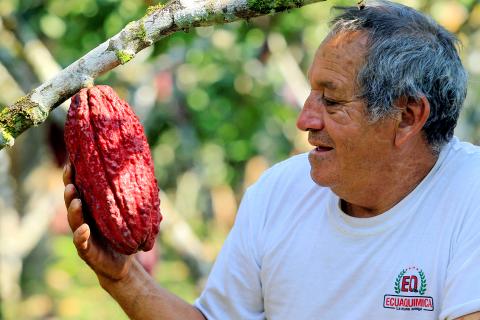People have been enjoying chocolate far longer than previously known, according to research published on Monday detailing the domestication and use of cacao beginning 5,300 years ago at an ancient settlement in the highlands of southeastern Ecuador. Scientists examined ceramic artifacts at the Santa Ana-La Florida archeological site, a remarkably preserved village and ceremonial center that was part of the Mayo-Chinchipe culture of the Andes, and found abundant evidence of the use of cacao, from which chocolate is made.
The study indicates cacao was domesticated roughly 1,500 years earlier than previously known, and that it occurred in South America rather than in Central America, as previously thought. A tropical evergreen tree called Theobroma cacao bears large, oval pods containing the bean-like cacao seeds that today are roasted and turned into cocoa and multitudes of chocolate confections, although chocolate at the time was consumed as a beverage.
The scientists found evidence of cacao’s use at the site over a period starting 5,300 years ago — more than 700 years before building of the Great Pyramid of Giza in ancient Egypt — until 2,100 years ago. They found cacao starch grains in ceramic vessels and pottery shards. They also detected residue of a bitter compound found in the cacao tree but not its wild relatives, evidence that the tree was grown by people for food purposes, as well as DNA fragments from the cacao tree.

Photo: Reuters
照片:路透
“They clearly drank it as a beverage, as shown by its presence in stirrup-spout pots and bowls,” said University of British Columbia anthropologist and archaeologist Michael Blake, who helped lead the study published in the journal Nature Ecology & Evolution. “The presence of cacao starch grains likely means that they ground the seeds to make the beverages, and so probably, though we aren’t certain, fermented the seeds as well, before grinding them,” Blake added.
Archeological evidence indicates cacao domestication moved into Central America and Mexico about 4,000 years ago. Before European conquerors arrived in the Americas five centuries ago, great civilizations like the Aztecs and Maya prepared chocolate as a drink, mixed with various spices or other ingredients. “The freshly picked ripe cacao pods have a delicious sweet pulp around them, and mixed together it all has a very mild chocolate taste,” Blake said. “The chocolate confections today contain a great deal of sugar, and this is very different from the indigenous uses of cacao reported in the historical records from the 1500s and 1600s.”
(Reuters)
根據週一發表的一份研究顯示,人類享用巧克力的歷史比先前所知的還要悠久。該研究詳細指出,在厄瓜多東南部高地的一處古老聚落,發現五千三百年前已開始出現可可豆的人工培植和食用跡象。在聖塔安娜─佛羅里達考古遺址──當地保存著狀況絕佳的村落遺跡,曾作為儀式中心,屬於安地斯山脈「馬由─欽奇佩」文化圈的一部分──科學家仔細檢驗出土的陶瓷工藝品,並發現充分證據顯示使用可可豆,也就是製作巧克力的原料。
研究指出,人工培植可可豆的時間點比先前所知還要再往前推大約一千五百年,並且始於南美洲,而非之前認為的中美洲。可可樹是一種熱帶常青樹,會結出大而橢圓形的豆莢,包覆著像豆子般的可可種子。今日,可可種子會在烘培後被做成可可粉和各式各樣的巧克力糕點,不過巧克力在當時其實是被用來作成飲料喝下肚。
科學家在該遺址發現使用可可豆的證據,當地的人類活動始於五千三百年前──比古埃及建造吉薩大金字塔的時間還要早了七百多年──到兩千一百年前。在陶瓷容器和陶器碎片中,科學家找到可可豆的澱粉粒,還偵測到只會在可可樹中發現,卻不存在於野生近親樹種中的一種苦澀化合物殘餘,這是人類為食用目的而種植可可樹的證據,同時也發現可可樹的DNA片段。
英屬哥倫比亞大學的人類學暨考古學家麥可‧布雷克指出:「可可豆出現在蹬型壺嘴陶罐和碗裡,證明當地人明顯是把可可豆作成飲料來喝。」布雷克協助主導這份發表於《自然─生態學與演化》期刊的研究,他補充說:「可可豆澱粉粒的存在,表示當地人會把可可豆磨碎來做成飲料,所以,雖然我們還不能確定,他們或許也會在磨碎可可豆前先進行發酵。」
考古證據顯示,可可豆的人工培植技術大概在四千年前傳入中美洲和墨西哥。五個世紀前,當歐洲的征服者們抵達美洲時,諸如阿茲特克和馬雅等偉大文明皆會把巧克力調製成飲料,裡面加入各種香料和其他成分。布雷克表示:「剛摘下來的新鮮可可豆莢裡面含有美味而香甜的果肉,如果把它跟可可豆混在一起,就會產生一種非常溫潤的巧克力口感。」這名學者也說:「今日的巧克力糕點加入大量的糖分,這跟十六世紀和十七世紀留下來的歷史紀錄中,對於當地可可豆使用方法的描述是大相逕庭的。」
(台北時報章厚明譯)

A: Yet another shopping mall has just opened in Taipei. B: Do you mean the Mitsui Shopping Park LaLaport Nangang? A: Yeah, the shopping mall run by Japanese Mitsui & Co. opened last week. B: I hear the mall features about 300 stores, Vieshow Cinemas and Japanese Lopia supermarket. A: With the opening, a war is breaking out between Taipei’s department stores. A: 台北又有新的購物商場可逛啦。 B: 你是說Mitsui Shopping Park LaLaport 南港? A: 對啊這家日本三井集團旗下的商場上週開幕。 B: 聽說商場有威秀影城、樂比亞日系超市,還有多達300家專櫃。 A: 新商場一開幕,看來又要掀起一場百貨大戰啦! (By Eddy Chang, Taipei Times/台北時報張迪)

A: Hey, didn’t you go to the opening of the Mitsui Shopping Park LaLaport Nangang last week? B: Yeah, there are about 300 shops, including the first overseas branch of Japan’s Mahou Dokoro — a famous Harry Potter-themed store. A: Wow, I’ve always wanted to get a magic wand. B: There are also a bunch of great restaurants, such as Smart Fish hotpot restaurant. A: I wish I had Harry Potter’s “apparition” and “disapparition” magic, so I could teleport to the mall right now. A: 你上週不是有去LaLaport南港的盛大開幕嗎?有什麼特別的? B: 那裡有多達300家專櫃,包括魔法之地的海外首店——它可是日本知名的《哈利波特》專賣店。 A: 哇我一直想買根魔杖。 B: 另外還有各式各樣的美食,像是林聰明沙鍋魚頭。 A: 真希望我也有哈利波特的「現影術/消影術」魔法,能瞬間移動到商場去! (By Eddy Chang, Taipei Times/台北時報張迪)

When it comes to movies, some people delight in watching spine-chilling horror films. Surprisingly, apart from containing a few scares, horror movies may also offer an unexpected __1__. According to a study, watching 90 minutes of a scary movie can burn an average of 113 calories, which is roughly __2__ to taking a 30-minute walk. Researchers from the University of Westminster carried out an experiment in which they __3__ participants’ oxygen intake, carbon dioxide output, and heart rates while they were watching horror movies without any distractions. The results revealed that physiological responses to fear play a crucial role

Dos & Don’ts — 想想看,這句話英語該怎麼說? 1. 你覺得這部電影怎樣? ˇ What do you think of the movie? χ How do you like the movie? χ How do you think of the movie? 註︰What do you think of = What is your opinion of。 think 的受詞是 what,不能用 how。 2. 你認為哪一個歌星唱得最好? ˇ Which singer do you think is the best? χ Do you think which singer is the best? 註︰英語中 which singer 似乎是 do you think 的受詞,實則 do you think 是插入語,其他例子如下: 你以為他喜歡誰? Who do you think he likes? 你以為我住在哪裏? Where do you think I live? 你想我昨天在公園裏碰到了誰? Whom/Who do you think I met in the park yesterday? 3. 他不論到什麼地方,總是帶著一把雨傘。 ˇ No matter where he goes, he